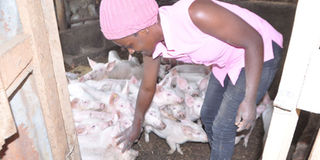Why China’s swine fever scourge should worry you

A farmer screens her pigs for vaccination. FILE PHOTO.
What you need to know:
African Swine Fever (ASF) which is caused by a virus, is fatal and has no cure or vaccine. Last week alone, China is estimated to have destroyed about 1.2 million pigs due to the outbreak.
The last time we discussed African swine fever (ASF) was 2018. In the article, we highlighted the devastation the disease had done on various farms.
At around the same time, unbeknown to most farmers, their Chinese counterparts had just begun experiencing the same problem.
It was the first emergence of the disease in the Asian country, which is the largest producer and consumer of pork globally. The Chinese outbreak has run amok. It has turned out to be a pig holocaust, threatening to completely get out of control not only in the country but also in most of South East Asia and other neighbourhood nations. According to reports from the Food and Agriculture Organisation (FAO), the disease has to date spread to Mongolia, Republic of Korea and the People’s Democratic Republic of Korea.
The others comprising Indonesia, Philippines, Cambodia and Lao People’s Democratic Republic are struggling with the disease. Vietnam, Timor-Leste and Myanmar have also had their unpleasant encounters with the swine scourge.
Pig farmers have been asking whether they should be concerned with the Chinese-South East Asian ASF outbreak. The answer is a big yes. Well, it is always said that one’s misfortune may be another’s opportunity.
Minimise the risks
Before the outbreak, the Chinese pig population was estimated at about 500 million. China is estimated to have destroyed about 1.2 million pigs due to the outbreak. Many farmers have also depopulated their farms to minimise the risks.
Vietnam, on the other hand, is reported to have slaughtered about six million pigs due to the infection. The net result is a great reduction in pork supply, leading to an increase in prices. On the negative side, the ASF outbreak could still spread to East Africa and other regions unless concerted efforts are employed to contain it in the affected countries. This fear is not far-fetched because we have seen other diseases in the past spreading from one region to another. In the past 20 years, some of the diseases that have spread across the world include avian and swine influenza in poultry and humans, Severe Acute Respiratory Syndrome (SARS) in humans and Ebola in humans. In 1918-1919, the deadliest global influenza outbreak occurred and spread widely. It infected some 500 million people and killed about 50 million worldwide. The virus is now known to have mixed human and avian influenza genes.
There is no cure
At the time of the influenza outbreak, there were neither vaccines to prevent the disease nor antibiotics to treat the bacterial infections that complicate influenza attack.
Control of the outbreak was mainly done by non-pharmaceutical interventions comprising isolation, quarantine and good personal hygiene. Use of disinfectants and limitation of public gatherings were also employed.
The Chinese ASF outbreak echoes the global influenza outbreak, only that it just affects pigs. It would be a human nightmare if the ASF virus jumped species and became infective to humans.
There is no cure for ASF and almost all the animals that get infected die. To add misery to pork producers, all animals in infected herds must be destroyed to control the disease. In some countries such as the Philippines, all pigs within one kilometres of an infected farm must be slaughtered.
For effective control of ASF, FAO recommends strong disease control support from the highest level in government and a good state of preparedness in a country, including disaster planning.
Daily Nation




